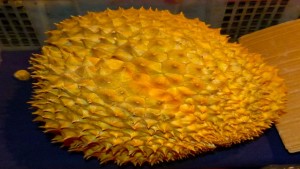Jia-Xiao Li, Peter Schieberle, and Martin Steinhaus, all researchers at the German Research Center for Food Chemistry, wanted to match the molecular structures of the aroma molecules with their odors to find the ones most responsible for the durian’s smell.
To do this, the scientists stationed a trained person at the end of an instrument called a gas chromatograph. They injected increasingly dilute durian extracts into the machine, which vaporizes the aroma molecules and separates them based on their boiling point. The person at the end of the machine sniffs the molecules leaving the machine and identifies their odors.
Then the scientists took samples of each group of aroma molecules identified by the people. They injected the samples into an instrument that determines the mass of molecules in the sample. Knowing the mass of a molecule, scientists can determine the types and numbers of atoms in the molecule (six carbons, two oxygens and twelve hydrogens, for example). From there, they can connect those atoms into a molecular structure (fruity ethyl butanoate in this example).
Li and colleagues identified 46 different aroma molecules, including fruity, skunky, honey, caramel, and roasted onion smells. Eight of the 13 most common molecules, identified at the lowest dilutions, were unknown in durian until now. The researchers write that they'd have to recreate the durian aroma without particular ingredients to determine the relative contributions of each aroma molecule without a doubt.
Most of the odiferous onion-like compounds contain sulfur. That’s not surprising because our noses are quite sensitive to sulfur. Natural gas companies lace the gas with a sulfur-containing compound so our noses can detect a gas leak.
As someone whose nose turns up when I turn on my gas stove, I admire the people who sniffed durian for this experiment. As a reward, I hope they get to work on experiments identifying hop aroma in beer or the scent of champagne.
